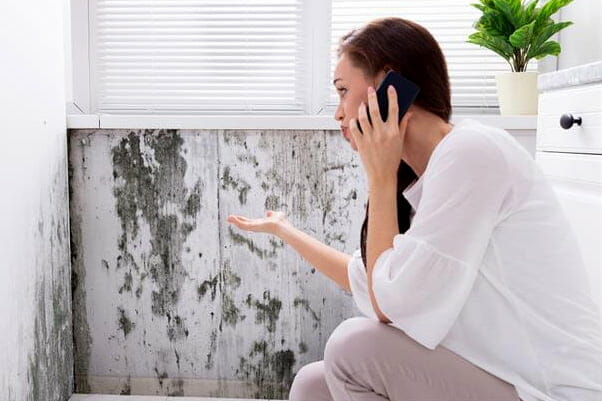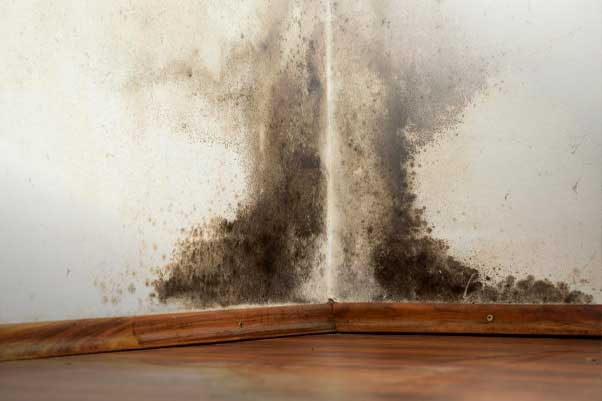How hazardous is mold exposure, really, and at what point should worry about coming into contact with it start to emerge?
There are no hard and fast rules about what levels of mold might be considered dangerous to your health. Depending upon what type of mold you are dealing with, anywhere between 3,000 and 4,000 spores per cubic meter of air could be considered allergenic. For some types of mold, this number could be as low as 100 spores per cubic meter.
When it comes to mold exposure, particularly in your home, there are a few things you should make yourself aware of. The types of molds that might be growing in your home, the levels of airborne spores you could be exposed to, and the signs of mold infestation to look out for are all important in the battle against mold growth in your home.
Should I be worried about mold?

While there can often be a lot of worry and concern surrounding the issue of mold exposure, there can also be a lot of fear-mongering around this issue too.
One of the most important things to remember when it comes to mold exposure is that you are exposed to mold every single day. Whether in the air or on surfaces, indoors or outside, mold is an inextricable part of the ecosystem and can be found almost anywhere.
The only time you should be concerned about exposure to mold and dangerous levels of mold spores is when you are exposed to excessive amounts of mold in an enclosed area.
Excessive mold growth is easy to spot, or in some cases, smell. Mold will be visible as small spots or larger patches, often appearing on tiles, walls, carpets, and furniture. It is often accompanied by a damp, musty smell.
Although these mold growths might be easy to see, it is the invisible airborne spores from mold that present an issue to your health. It is these spores that allow mold growths to spread, and it is also these spores that will trigger allergies, asthma, and other respiratory issues if allowed to grow for too long.
When it comes to measuring mold levels or determining what levels of mold could be considered dangerous or deadly, we usually refer to the percentage of mold spores per cubic meter of air.
How many mold spores are dangerous?

By definition, a mold spore count is simply the number of mold spores in a cubic meter of air. It is very similar to the method used for pollen counts.
To fully understand what this mold spore count means in real-world terms, it is helpful to understand the size of a mold spore.
On average, a mold spore is one micron wide. In comparison, that makes it at least 50 times smaller than the width of a human hair, which typically measures between 50 and 80 microns wide.
Although there is no definitive answer on what constitutes a safe quantity of mold, or what an acceptable mold spore count is, it is typically thought that people will begin to notice a mold problem when the mold spore count reaches 3000 spores of mold per cubic meter of air.
Most mold spore counts in your home are benchmarked against a mold spore count that has been conducted outdoors. Because mold counts will differ depending on factors such as your environment and the time of year, it is usually helpful to understand the typical mold count in an open, exposed area before jumping to any conclusions about the mold inside your home.
That being said, if you are able to smell or see mold inside your home, you should make an effort to have it cleaned up immediately and take measures to prevent any future mold growth.
The lack of guidance around what is considered a safe or dangerous mold spore count is all the more reason to tackle any mold issue head-on. Once they have taken root, mold growths can quickly become infestations, and you may find that you are dealing with a mold spore count that is much higher than you originally anticipated.
Safe and toxic levels of mold by type
Not all molds are created equal. Some, such as the infamous toxic black mold, can cause much more serious health issues in much greater volumes if left unchecked. Even molds such as Penicillium, which boast a much more favorable position in human history, can be just as injurious to your health if left too long.
We have put together a quick guide on some of the most common household molds, including information on what they look like and what levels of these molds might be considered safe or toxic.
Aspergillus mold
Appearance
Aspergillus is a very common type of mold, usually found in decaying vegetation. It can also be found in the home in air conditioning vents. Aspergillus can be found in a variety of colors, including white, yellow, green, brown, or black, depending on the specific species. It typically has a velvety texture.
Safe and toxic levels
People who suffer from asthma can be allergic to aspergillus spores. These spores can trigger an asthma attack or, in extreme cases, aspergillosis. Aspergillosis results in severe inflammation of the lungs and can trigger extreme asthma attacks.
As aspergillus is common, it is likely that there are some aspergillus spores in the air at any given time. In susceptible persons, such as asthmatics, mold spore counts of aspergillus can be dangerous at between 500-1500 spores per square meter.
Stachybotrys mold
Appearance
Also known as toxic black mold, Stachybotrys is greenish-black in appearance. It requires a constant source of moisture in order to grow, and can usually be found in the aftermath of flooding or when a serious leak has occurred in the home.
Safe and toxic levels
Given its toxicity, which comes from the production of mycotoxin, even comparatively very low levels of Stachybotrys can be a cause for concern. Stachybotrys can cause headaches, respiratory issues, rashes, and sometimes even blood poisoning. A mold spore count as low as 50-200 spores per square meter can be an issue with Stachybotrys mold.
Cladosporium mold
Appearance
Another common type of mold, Cladosporium can be found in wet or damp areas such as the bathroom, laundry, or kitchen. It can grow on a variety of surfaces, from carpets and fabrics to floors and walls. With over 500 species of Cladosporium, it can be difficult to distinguish the growths of this mold, but it will usually appear as green, black, or brown spots.
Safe and toxic levels
As with aspergillus, Cladosporium is fairly common and there are always likely to be some Cladosporium mold spores in a mold spore count. Although it does present an issue for people with mold allergies, Cladosporium is one of those molds that typically do not cause too many issues until they reach the 3000 spores per square meter point.
Curvularia mold
Appearance
Curvularia tends to grow on wooden surfaces in damp areas of the home. This could include window sills, walls, tabletops, and benches. Its color can range from gray to black or brown and has a woolly, velvety appearance. As it looks similar to many other mold varieties, it is hard to positively identify auricularia unless viewing its spores under a microscope.
Safe and toxic levels
Apart from presenting an issue to human health, auricularia also presents an issue to plant health. In fact, it is better known as a plant pathogen than a human pathogen and is regarded as quite the pest in many farming and agriculture circles.
If auricularia mold spore counts reach the standard 3000 spores per square meter mark, any auricularia mold present should be removed immediately as it presents a risk to the health of both humans and plants in the immediate area.
Chaetomium mold
Appearance
In its initial stages of growth, chromium mold is white in appearance, with a cottony texture. As this fast-growing mold variety matures, its color changes to a greenish-black.
Safe and toxic levels
Chaetomium has strong links to asthma and can cause a variety of issues in susceptible persons, including those with mold allergies. As such, mold spore counts at levels of 1500 spores per square meter can be considered dangerous for the risk they present to these people.
If Curicularia mold spore counts reach the standard 3000 spores per square meter mark, any Curvularia mold present should be removed immediately as it presents a risk to the health of both humans and plants in the immediate area.
Memnoniella mold
Appearance
Memnoniella is often found growing with toxic black mold and is even similar in appearance to the greenish-black Stachybotrys. However, Memnoniella is much smaller than Stachybotrys, meaning that it is able to be inhaled more easily.
Safe and toxic levels
Given that it grows companionably with Stachybotrys, very low levels of memnoniella are a cause for concern. A mold spore count between 50 and 200 spores per square meter of air requires immediate attention when it comes to memnoniella mold.







